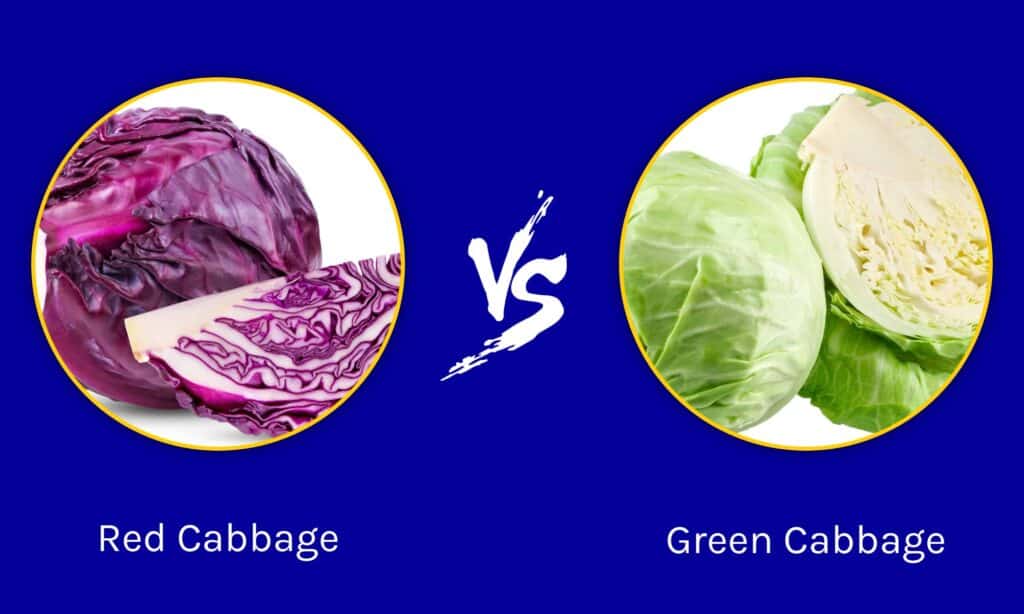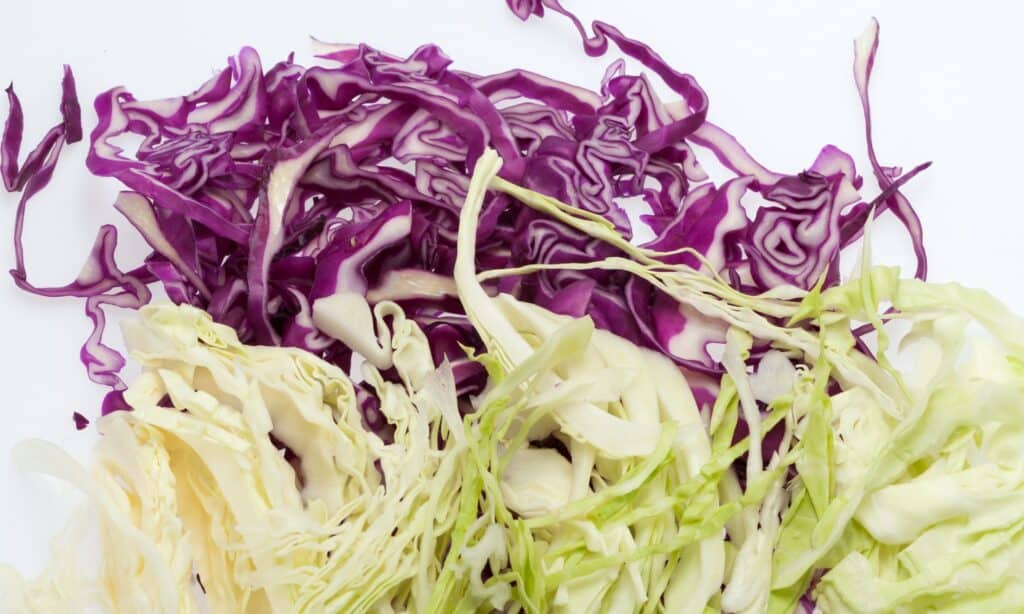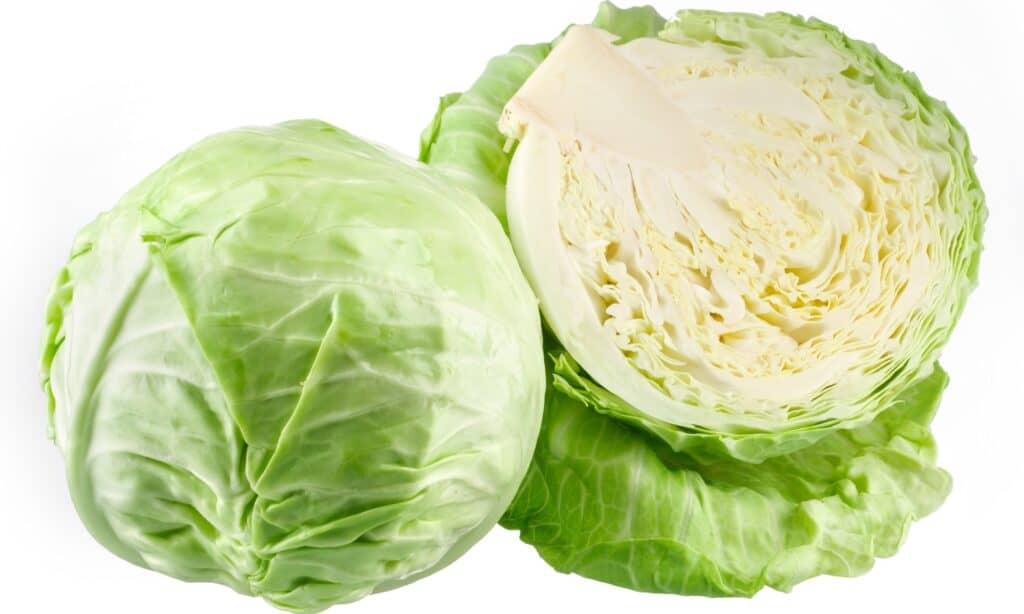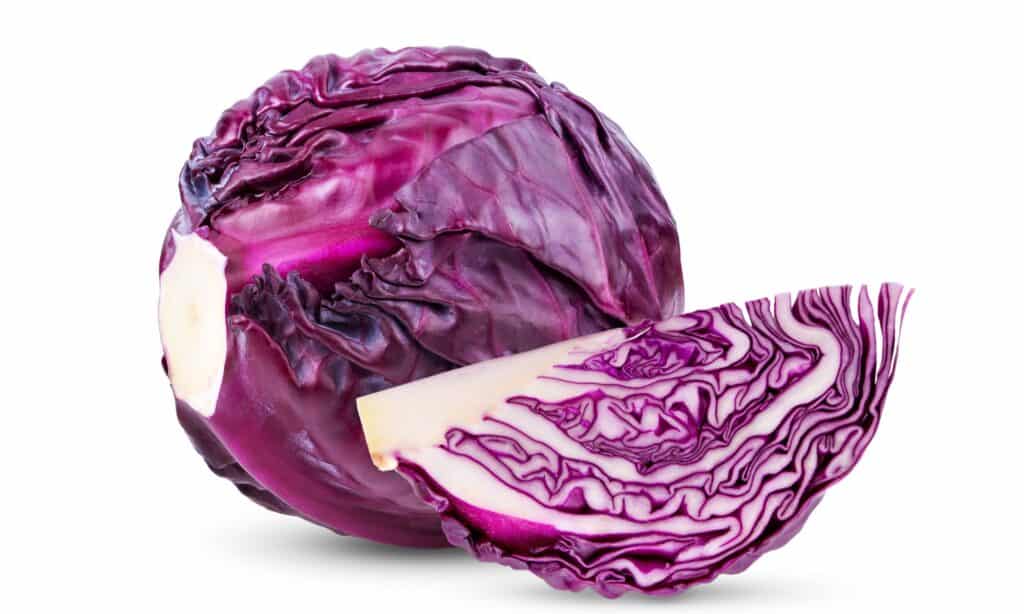While it may seem obvious, do you know all of the differences between red cabbage vs green cabbage? Are they the same in terms of their nutritional value, and do they grow in a similar fashion? If you are wondering which type of cabbage to use in a particular recipe or meal, you’re in the right place.
In this article, we will compare and contrast everything you need to know about red cabbage and green cabbage. This should give you a full understanding of both vegetables, as we will address their physical description, their preferred uses, and the ways in which they are special and nutritionally valuable. Let’s get started and talk all about cabbage now!
Comparing Red Cabbage vs Green Cabbage

| Red Cabbage | Green Cabbage | |
|---|---|---|
| Classification | Brassica oleracea var. capitata f. rubra | Brassica oleracea var. capitata |
| Description | Round, purplish red vegetable made up of compact leaves. Dense and heavy with white inner leaves when chopped or cut. Peppery and floral taste that gets sweeter when roasted or sauteed. | Round, light green vegetable made up of compacted leaves. Dense, heavy, and ranges in shades of green, but typically remains light. Peppery and sweet, mild in flavor, and only gets sweeter as you cook it. |
| Uses | Eaten raw, sauteed, stir fried, roasted, pickled, and more. Needs to be cooked carefully, as the red color in the leaves can bleed into other foods or water | Eaten raw, sauteed, roasted, stir fried, pickled, steamed, boiled, fermented, and more. Leaves are sturdy enough that you can wrap things in them, even after blanching |
| Nutrition Info | More nutritionally dense compared to green cabbage, given its distinct color; full of Vitamin A, Vitamin C, and iron | Less nutritious compared to red cabbage, but still extremely beneficial. Full of Vitamin K and Vitamin C, as well as water |
| Special Features | Red cabbage pigment is being used to dye certain things, including pharmaceuticals! | Originating in China sometime during 4000 BC, cabbage is one of the oldest vegetables known to man! |
Key Differences Between Red Cabbage vs Green Cabbage

Red cabbage has more nutritional value per serving compared to green cabbage.
©iStock.com/wjarek
There are a number of key differences between red cabbage and green cabbage. For example, red cabbage is a beautiful red or purple color, while green cabbage is light green in color. In addition, red cabbage has more nutritional value per serving compared to green cabbage. Finally, red cabbage needs to be prepared in a different way compared to green cabbage due to its unique color.
Let’s go over all of these differences in more detail now.
Red Cabbage vs Green Cabbage: Classification
When it comes to the scientific classification of both red cabbage and green cabbage, they are naturally from the same plant family. Belonging to the mustard family, both red cabbage and green cabbage are related to one another. In fact, they are basically identical, except that they are considered two different varieties of cabbage. Looking at it in more detail, red cabbage is known as capitata f. rubra, while green cabbage is known simply as capitata.
Red Cabbage vs Green Cabbage: Description

Red cabbage needs to be prepared in a different way compared to green cabbage due to its unique color.
©iStock.com/MamaMiaPL
There are some obvious differences in the physical description of green cabbage versus the description of red cabbage. For example, red cabbage is a beautiful red or purple hue, while green cabbage is light green in color. Physically, these two types of cabbages look extremely similar, as they are rounded heads of thick leaves, and extremely compact and dense.
When you cut into a red cabbage, you will notice purple leaves with white insides, while green cabbage appears more yellow-green in appearance when it is cut. Otherwise, the physical descriptions of these plants remain identical, though red cabbage has the tendency to bleed its beautiful red pigments onto nearby foods, while green cabbage does not stain.
Red Cabbage vs Green Cabbage: Uses

When you cut into a red cabbage, you will notice purple leaves with white insides, while green cabbage appears more yellow-green in appearance when it is cut.
©iStock.com/Tim UR
Many people argue that red cabbage and green cabbage can be used interchangeably in recipes and in a culinary capacity. This is primarily true, given their similarities in flavor. However, red cabbage tastes more floral and less sweet compared to the average head of green cabbage. This leads to a slight difference in their popular cooking methods.
For example, red cabbage is popular when pickled or roasted, wild green cabbage is popular in raw forms or lightly steamed. However, both options are delicious in any form, though it is important to note that red cabbage will bleed its color onto anything that you cook it with. In addition, green cabbage is often used as wraps or stuffed, while red cabbage is rarely used this way.
Red Cabbage vs Green Cabbage: Nutrition Information
One of the primary differences between green cabbage and red cabbage lies in their nutritional value and vitamins present. For example, red cabbage is more nutritionally dense compared to green cabbage, given the unique chemical makeup that also gives red cabbage its color. Additionally, red cabbage is higher in iron, Vitamin A, and Vitamin C compared to green cabbage, though green cabbage contains more Vitamin K compared to red cabbage.
Red Cabbage vs Green Cabbage: Special Features

Red cabbage tastes more floral and less sweet compared to the average head of green cabbage.
©iStock.com/supamas lhakjit
Given the fact that you can use green cabbage and red cabbage in culinarily similar ways, they still both manage to have special features that are distinct from one another. For example, red cabbage is being used to dye certain foods and items, given its unique color. Green cabbage is one of the oldest vegetables ever produced, grown as far back as the year 4000 BC!
The photo featured at the top of this post is © iStock.com/wjarek
Thank you for reading! Have some feedback for us? Contact the AZ Animals editorial team.






